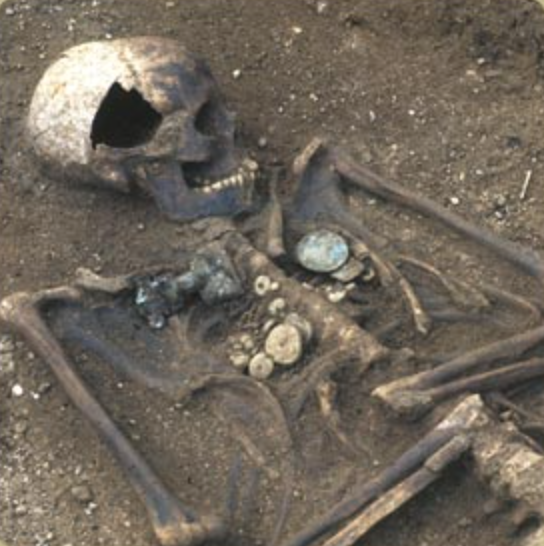Berinsfield
- Period: Anglo-Saxon
- Location: UK
- Burials: 114 individuals
- Archaeologists: K. Privat, T. O’Connell and M. Richards
- Related Keyword/Categories: Identity, Diet, Inhumation

A study by Privat, O’Connell and Richards (2002) examines an early Anglo-Saxon population’s human and animal remains in order to determine diet. His goal is to not only characterize the diet of the burial community as a whole but to find patterns within sub-groups as well that will correspond to social structure. Little is known about this period between the end of the Roman Empire in Britain (410 CE) to the rise of the Christian Anglo-Saxon kingdoms (7th century CE), especially regarding the daily life of the people. By using stable isotope analysis of carbon and nitrogen ratios, Privat, O’Connell and Richards (2002) argue we can begin to learn more about the diet and the daily life of the different groups in the community. The site under investigation includes 114 individuals from the site of Berinsfield in southern England. The cemetery was dated to the mid-5th to late 6th/early 7th century using artifacts with known chronological dates. Prior research at the cemetery has identified distinctive gendered assemblages of artifacts, lifecourse age groups, and potential household groups within the community. Privat, Connell and Richards (2002) goal is to explore the variation in diet in these different groups that have been identified. Carbon isotope ratio is a reflection of consumption of marine versus terrestrial food sources, and nitrogen can be used to determine one’s position in the food chain, basically a reflection of protein consumption. Samples for stable isotope analysis were taken from 93 humans, 1 pig, 1 dog, 2 ovicaprids (sheep/goat), 3 foxes, 3 horses and 3 cows from the Berinsfield site. Overall, based on carbon ratios, the community had a diet based almost entirely upon temperate terrestrial C3 and possibly freshwater resources, with no consumption of saltwater marine resources. The variation in nitrogen was more pronounced, showing variation between low consumption of herbivores to high consumption of omnivores. Nitrogen values are highest among infants, and it decreases with age. The changes in diet with age are more pronounced in older males than females, although overall there was no major difference between the sexes. Wealth was determined by the burial of the individuals. Graves were classified by the number of artifacts found into three ranked groups: poor, intermediate and wealthy. There was no strong difference between the wealthier two groups, but the poorest group had the highest ratio of nitrogen isotopes. This suggests that the poor consumed a greater proportion of aquatic food or omnivore protein. This also suggests that the wealthier consumed more herbivore meat and dairy products, which requires time and resources to get. The site was also divided into household groups, and it is thought that households would have more similar diets within group than between. The isotopic evidence does not support this claim. Based on this analysis, Privat, O’Connell and Richards (2002) draw a number of conclusions. First, the consumption of meat was not a privilege, but rather normal for the entire community. Second, wealthy individuals consumed more domesticated meats and animal byproducts than poor individuals. Third, while males and females are strongly differentiated in artifacts they had similar diet. However, male diet did change with age, with individuals in their 20’s to 30’s having a diet more reflective of wealthy than those older and younger. Female diet didn’t have any pronounced changes. This study is interesting and beneficial because it combines isotopic data with archaeological and textual evidence to create a more nuanced interpretation of Anglo-Saxon society.
References: Privat, K., O’Connell, T., & Richards, M. (2002). Stable Isotope Analysis of Human and Faunal Remains from the Anglo-Saxon Cemetery at Berinsfield, Oxfordshire: Dietary and Social Implications Journal of Archaeological Science, 29 (7), 779-790 DOI: 10.1006/jasc.2001.0785


